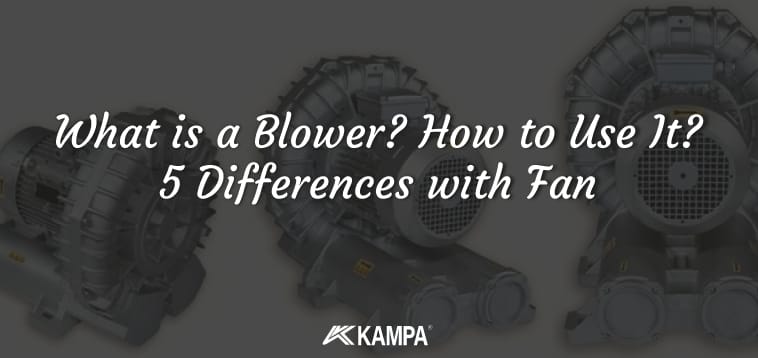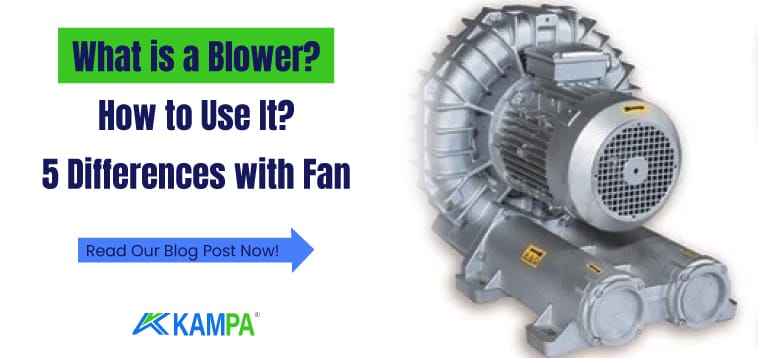What is a Blower? How to Use It? 5 Differences with Fan
Mechanical or electromechanical devices used to index the gas flow wherever required for ventilation, cooling, transportation, etc. are called blowers.
It acts as a blower. The bellows inside the blowers increases the air flow while cooling at the same time. It provides high flow rate and low pressure.

What are the Differences Between Fan and Blower?
Although they are used for air circulation, they have different characteristics. A fan acts on the air around a room or an area, while a blower focuses on a specific point.
A fan is a machine used to create flow in a fluid such as air. It consists of blades or vanes that rotate and move air. This rotating blade and hub assembly is known as an impeller, a rotor or a runner.
Impellers help to direct the air flow and produce air at low pressure. A blower is defined as a machine used to produce large volumes of gas with a moderate increase in pressure.
Similar to fans, an air blower is used to create air. However, it only provides air at a specific position.
It consists of a wheel with a small blade around the circumference and a casing to direct the air flow towards the edge. The casing in the center of the wheel uses centrifugal force to push the air forward.
Based on the design of the blades and their effect on the driving air, the efficiency of the fans and blowers is determined.
Similarly, depending on the blades, size, energy efficiency and airflow, they are further classified and differentiated from each other.
In terms of size, blowers are generally larger compared to fans. In terms of energy, fans consume less energy and produce more efficiency than blowers.
In terms of airflow, it can be seen that blowers generate more airflow than fans, depending on the discharge ratio of the suction pressure.
| FAN | BLOWER | |
|---|---|---|
| MODE OF OPERATION | A fan circulates air around the entire room or space. | It circulates air only over a certain area. |
| PRESSURE | It uses less pressure to produce a large amount of gas. | It uses high pressure to produce large quantities of gas. |
| PRESSURE RATIO | The pressure ratio is below 1.1. | The pressure ratio is 1.1 to 1.2. |
| TYPES | Axial flow fans. Centrifugal fans. | Double stage Single stage |
| CONTENT | It consists of an electrically driven motor and propeller. | It consists of a fan, outer cover, inlet, outlet. |
How to Choose a Blower?

Choosing the wrong vacuum fan can result in poor performance as well as unnecessary electricity bills. In this section we will cover the considerations for the right choice for industrial application.
- Determine the location.
- Measure the space you will use.
- Decide on the air flow direction.
- Design a project of the installation layout. Ducts, equipment and process…
- Decide on the values of the air flow required in the air application area.
- Answer questions such as the temperature of the air entering the blower, where the air will enter, how it will enter
- Find out the pressure drop in the air flow outside the duct.

Differential pressure, type, year of manufacture, T1 inlet temperature, Q1 suction capacity, p2 pressure and motor power should be selected carefully.
In line with your answers to all these items, it will be revealed what kind of product you need as a draft. Please contact us for more detailed product reviews.
Blower Application Areas ?
Can be divided into groups according to the field of application.
-For boiler applications,
-Dust collector,
-Furnace,
-Paint shop,
-Kitchen and exhaust,
-For process equipment
-Fume, exhaust, ventilation
What benefits the use of a blower brings to the field
Provides regular air and gas flow because they use oil-free air or gas. Products with long-lasting use do not require much cost for maintenance. The issue you will have the most problems with will be the noise level, it will be beneficial to pay attention to the noise level when choosing.
Click here for detailed information about fans. Click here for blower prices.
Buy affordable blower models and types that you can use in every area.

